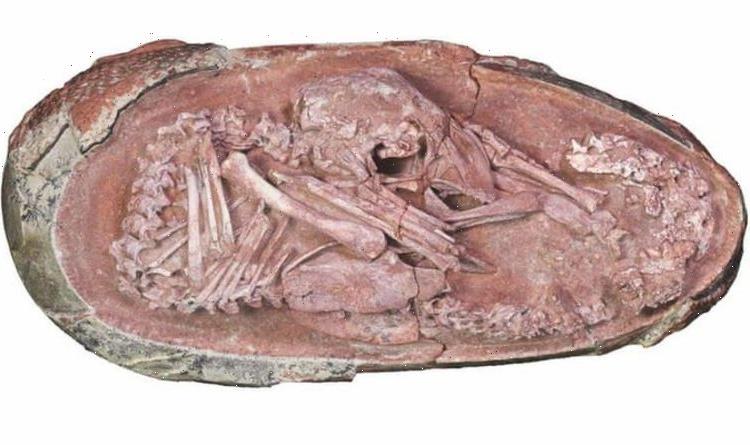Perfectly preserved dinosaur embryo discovered in China
We use your sign-up to provide content in ways you’ve consented to and to improve our understanding of you. This may include adverts from us and 3rd parties based on our understanding. You can unsubscribe at any time. More info
It was found in Ganzhou, southern China, and is believed to date back at least 66 million years. It is believed to be a toothless theropod dinosaur, or oviraptorosaur, and has been named Baby Yingliang. Palaeontologist Dr Fion Waisum Ma said it is “the best dinosaur embryo ever found in history”.
She told Sky News: “It is so well preserved we can look at how this little dinosaur laid inside its egg and can compare its posture with other dinosaurs.
“If we look at its posture, we can see that it is very close to hatching like modern-day birds.”
It will help scientists to research the link between dinosaurs and modern birds.
The fossil shows the embryo was in a curled position known as “tucking,” which is a behaviour seen in birds shortly before they hatch.


Dr Ma added: “This indicates that such behaviour in modern birds first evolved and originated among their dinosaur ancestors.”
Oviraptorosaurs, which means “egg thief lizards,” were feathered dinosaurs that lived in what is now Asia and North America between 100 and 66 million years ago.
The embryo, housed in Yingliang Stone Nature History Museum, is around 27cm long from head to tail and lies inside a 17-cm-long elongatoolithid egg.
Baby Yingliang was identified as an oviraptorosaur due to its deep, toothless skull.
Oviraptorosaurs are a group of feathered theropod dinosaurs, closely related to modern-day birds, known from the Cretaceous of Asia and North America.

Professor Steve Brusatte from the University of Edinburgh, part of the research team, said: “This dinosaur embryo inside its egg is one of the most beautiful fossils I have ever seen.
“This little prenatal dinosaur looks just like a baby bird curled in its egg, which is yet more evidence that many features characteristic of today’s birds first evolved in their dinosaur ancestors.”
The egg was first uncovered in 2000, but put into storage for 10 years.
It was only when construction work began on the museum and old fossils were being sorted through that researchers turned their attention to the egg, which they suspected was holding an embryo inside.
DON’T MISS:
Archaeologists stunned at shipwreck ‘frozen in time'[SPOTLIGHT]
Truss in furious Brexit showdown as EU threaten £80bn betrayal [INSIGHT]
David Attenborough stunned by archaeological goldmine in UK [REVEAL]


Part of the dinosaur’s body is still covered by rock and researchers will use advanced scanning techniques to create an image of its full skeleton.
Dinosaurs first appeared during the Triassic period, between 243 and 233.23 million years ago, although the exact origin and timing of the evolution of dinosaurs is the subject of active research.
They became the dominant terrestrial vertebrates after the Triassic–Jurassic extinction event 201.3 million years ago.
Their dominance continued throughout the Jurassic and Cretaceous periods.
The fossil record shows that birds are modern feathered dinosaurs, having evolved from earlier theropods during the Late Jurassic epoch.
Source: Read Full Article
